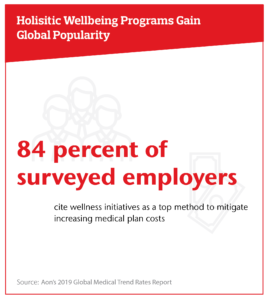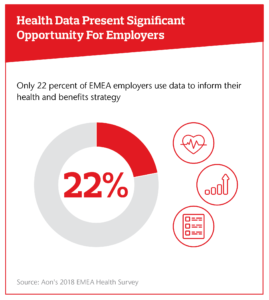OVERVIEW
Daily steps counted – check.
Glucose levels – check.
Personal trainer follow-up – check.
Stress-busting tips – check.
From shopping to hailing a ride, with the click of a button or a swipe of a screen, technology has revolutionized our everyday lives. But can it change the way we address the global issue of declining health?
More and more people around the world are suffering from chronic illnesses related to unhealthy lifestyles – such as diabetes and heart diseases. And the decreasing health of populations is having a big impact: not just on individuals’ quality of life but on health premiums and overall productivity.
Stephanie Pronk, senior vice president and leader of U.S. Health Transformation Team at Aon, states, “There isn’t a one-size-fits-all approach to health and wellbeing. Both an individual and an employer should look across a variety of issues – emotional, financial, physical and social – to create holistic approaches to improve one’s overall wellbeing.”
And as wellbeing programs continue to grow in popularity, what carries even more potential, she notes, is technology’s ability to bring these elements of health together to provide a more complete profile of an individual’s wellbeing.
The global health crisis could be answered with technology – specifically, with mobile health (mHealth) solutions, which cover everything from fitness trackers to biometric sensors. The market has developed significantly over the past few years and is expected to grow even further, to be worth more than $150 billion by 2025.
Technology can play a significant role in improving health outcomes. At the same time, the information generated from these personal devices also carries another benefit: line of sight into health-related data for both an individual and their organization.
IN DEPTH
According to Aon’s 2019 Global Medical Trend Rates Report, global average medical costs are rising at an annual rate of 7.8 percent. In many countries, this is much higher, even exceeding the local inflation rate by double-digit percentage points. Among the medical conditions increasing the costs are cardiovascular disease, cancer, high blood pressure and diabetes – most of which are manageable through changes in personal health behavior.

These factors have highlighted the importance of holistic wellbeing to employers. Organizations now need to address the emotional, financial and social factors – in addition to the physical ones – that can affect an employee’s overall health.
Applying Technology To Health And Wellbeing
While wellbeing programs once focused solely on physical health, there is now an awareness that broader issues such as mental illness, financial stress and poor social wellbeing also play a part in a person’s health. There’s also a recognition that each individual’s needs are unique, so wellbeing programs must be shaped accordingly. Thinking more inclusively about health could play a significant part in delivering more personalized health care and bettering the outcomes – and the usage of mHealth technology could be the start.
Some examples of mHealth tech:
Personalizing Health: Wearable Devices And mHealth Apps Wearable devices and health apps will give people greater insight into their health and the tangible improvements that changes in behavior can have on their wellbeing. Meanwhile, data collected through these devices and apps can allow health care professionals to track individuals’ and their progress toward becoming healthier.
Improving Health Outcomes: Smart Reminders And Digital Pillboxes Digital platforms can provide employees with health reminders and wellness tips or track outbreaks of diseases, such as colds or flus. Digital pillboxes can help patients track medications, ensure they’re taken as prescribed and transmit that data to caregivers.
Increasing Access: Telehealth The use of digital communications to acquire health services remotely will allow individuals to better access and manage their care.
Decision-Making Through Data: Predictive Analytics Analyzing an individual’s health data can help determine which patients are most at risk of chronic conditions and which could benefit from enhanced treatments. This can then be used to shape personalized wellbeing programs and help improve individuals’ satisfaction with the guidance they’re getting.


In Europe, Middle East and Africa (EMEA), Wellbeing Is A Priority, But There’s A Data Gap
Aon’s 2018 EMEA Health Survey found that the region’s employers clearly understand the impact employee wellbeing can have on their businesses. Of the employers surveyed, 95 percent see the correlation between health and employee performance.
“Health and wellbeing are high on the agenda for many employers right now in the EMEA region,” says Matthew Lawrence, chief broking officer of Health and Benefits, EMEA at Aon. “Employers increasingly recognize their role in trying to educate and improve individuals’ often poor lifestyle behaviors.”
The EMEA Health Survey did reveal some significant disconnects: despite recognizing the importance of employees’ wellbeing, only 40 percent of employers surveyed reported having a defined health strategy. And very few are taking advantage of data to shape their health and wellbeing strategies.
“Only 22 percent of employers use data to inform their strategy,” Lawrence says. “More employers need to develop a data-driven culture in health and wellbeing. A data-driven approach to health strategy can pay dividends in terms of supporting the case for investment, implementing targeted initiatives and measuring outcomes.”
APAC Employer’s Wellbeing Programs Can Capitalize On Tech-Savvy Consumers
The concept of wellbeing is gaining ground in other regions. In Aon’s 2019 Asia Pacific Employee Wellbeing Study, employers note increased employee engagement, improved productivity, reduced absences, and enhanced brand and talent attraction as top reasons for pursuing employee wellbeing programs. Interestingly, all those objectives tie into areas other than medical plan costs.
“Identifying objectives is the most important yet, oftentimes, most underrated step in designing employee wellbeing programs,” says Dr. Amitabh Deka, head of Wellbeing Solutions, South Asia and Aon Care at Aon. “The best-crafted wellbeing programs align directly with organizational objectives, Deka explains. By connecting employee health to a bigger-picture business goal, leaders can help build the case for the most appropriate wellbeing program for their employees.”
Health screening and promotion programs are the most common elements of Asia–Pacific employers’ wellbeing programs. Financial, mental and women’s health programs are receiving a growing amount of attention as well.
Technology also plays an important part in APAC employers’ wellbeing efforts. “From access to user experience to analytics, technology has revolutionized the way employers approach preventive health care and wellbeing, says Deka. “Even if it’s a personal smartwatch tracking steps to a larger digital wellbeing platform, technologies can provide an engaging experience for users to keep track of their health and wellbeing efforts.”
With more than half of the world’s population living in APAC and some estimates predict the region’s medtech market could increase to around $133 billion per year in 2020, both personal and employer use of the technology could skyrocket. “We are living in a time when we are more reliant than ever on our devices. We should expect to see people continue to use technology in more meaningful ways – from social media engagement to health tracking and sharing,” says Amanda Mercep, head of Wellbeing Solutions, North Asia at Aon. Mercep also sees that increased personal use of health-related sensors and wearable technologies provides even more opportunity for APAC employers’ wellbeing efforts.
Holistic Health And Wellbeing: Benefits Beyond Cost Containment
“Whether connected to workforce productivity or employee engagement initiatives, wellbeing – when done well – can extend much deeper into an organization than cost containment alone,” says Jim Winkler, global chief innovation officer of Health Solutions at Aon. When part of a broader health strategy, employers can decrease the specific health risk factors of their workforce and see productivity gains, improved employee attraction, retention and engagement or even boosted employer brand and reputation.
“Addressing health holistically and using various technologies to do so can pay off with more satisfied and engaged employees,” says Pronk. “And that’s good for the health of the business.”
The post The App Will See You Now: How Companies Are Personalizing Health appeared first on The One Brief.
